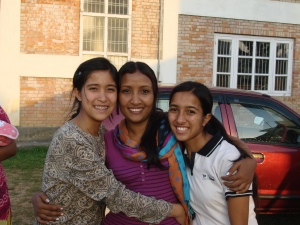Known as the “Himalayan paradise,” Nepal is home to the most magnificent tourist locations in the entire world, including the legendary Sherpas and Mount Everest. Yet lurking behind the majestic scenery and peaceful mountain terrain, a lucrative industry of modern-day slavery (that is sex trafficking) thrives.

Nepal’s history of sex trafficking can be dated back to the royal Rana family regime of 1846. The Ranas targeted beautiful girls and demanded that they work in their palaces, at times enticing some to become concubines. If the girl refused, she and her family would be beaten. When the Rana family lost power in 1950, they fled from Nepal and traveled to neighboring India. To support their affluent lifestyle, the Ranas prostituted their women. As the demand grew, the Ranas recruited women from the surrounding areas, including Nepal, beginning the now thriving sex trafficking industry between Nepal and India.
Nepalese women have also been governed by Nepal’s deeply embedded traditional patriarchal value system, where women were and are treated as mere luxuries and second-class citizens. Within Nepal, men have always been looked upon with greater importance than women. Nepal is broken up into lower and higher casts of society. The lower cast of Nepal is called the Dalit community, which amounts to over 20 percent of Nepal’s population. These individuals are denied access to land and subject to exploitative labor and segregation. Among this group, almost all of the women and children are illiterate and receive little if any pay for their work. They are easily coerced with hopes of a better job and better life outside of Nepal.
A third contributing factor in Nepal’s human trafficking problem is the struggling economy. As one of the poorest and least developed countries in the world, Nepal’s per capita Gross Domestic Product is only $1,500. Roughly 38% of Nepal’s population lives below the poverty line with approximately 42% unemployed. Such high rates of unemployment and extremely low family income create vulnerable women and children. Traffickers offer false hope of a better life to poor and hopeless individuals and lure them into a life of utter desolation.
 In an effort to attack this modern-day slavery within its borders, Nepal has enacted laws, domestically and internationally, to combat sex trafficking of women and children. Domestically, Nepal’s Interim Constitution (2007), provides that, “No physical, mental or any other form of violence shall be inflicted to any woman.” Later: “Traffic in human beings, slavery or serfdom is prohibited,” and that “Forced labor in any form is prohibited.” In 1986, the Fundamental Features of the Trafficking of Persons Control and Punishment Act was established which is a law “to combat the growing menace of trafficking in women and girls for prostitution.” In 1992, the Children’s Act was issued, which contains regulations on child labor laws, specifically in regards to sexual abuse. In 2000, the Child Labor Prohibition and Control Act of 2000 was established, prohibiting any work done by a child under fourteen; and forbids any false presentation or coercion to get a child to work. Finally, in 2007 the Trafficking in Persons and Transportation (Control) Act was enacted, providing that all forms of trafficking are prohibited within Nepal and punishable with imprisonment of up to 20 years. The act also provides a one to three months penalty imprisonment for brothel customers.
In an effort to attack this modern-day slavery within its borders, Nepal has enacted laws, domestically and internationally, to combat sex trafficking of women and children. Domestically, Nepal’s Interim Constitution (2007), provides that, “No physical, mental or any other form of violence shall be inflicted to any woman.” Later: “Traffic in human beings, slavery or serfdom is prohibited,” and that “Forced labor in any form is prohibited.” In 1986, the Fundamental Features of the Trafficking of Persons Control and Punishment Act was established which is a law “to combat the growing menace of trafficking in women and girls for prostitution.” In 1992, the Children’s Act was issued, which contains regulations on child labor laws, specifically in regards to sexual abuse. In 2000, the Child Labor Prohibition and Control Act of 2000 was established, prohibiting any work done by a child under fourteen; and forbids any false presentation or coercion to get a child to work. Finally, in 2007 the Trafficking in Persons and Transportation (Control) Act was enacted, providing that all forms of trafficking are prohibited within Nepal and punishable with imprisonment of up to 20 years. The act also provides a one to three months penalty imprisonment for brothel customers.
Internationally, Nepal has taken strides to sign on to legislation suppressing any and all forms of trafficking women and children. Nepal ratified the UN Convention for the Suppression of the Traffic in Persons and the Exploitation of the Prostitution of Others and also signed the Convention on Civil and Political Rights, making trafficking of girls illegal. On January 26, 1990, Nepal signed the Convention on the Rights of the Child which provides that trafficking in young girls is illicit and makes illegal economic exploitation, sexual exploitation, torture, inhumane and degrading treatment of children.
Shared Hope staff with Mithu, a survivor of trafficking,
on her wedding day!
When Shared Hope began its ministry of rescuing and restoring trafficked young women and children in Nepal, it was evident that the victims rescued from their traffickers desired to return home. Shared Hope’s wanted to make that wish come true.
In 2005, Shared Hope established and is now funding the Village of Hope “Asha Nepal,” 45 minutes outside of Kathmandu. At the Village of Hope, women receive vocational training, formal and non-formal education, and counseling. In fall 2009, Shared Hope International funded a grant that allowed high-level Christian schooling for the children at the Village of Hope in Nepal, reducing the young women and children’s chances of being lured into unsafe environments. Village of Hope is a home that can protect once trafficked Nepalese girls and helps them to acquire skills and education necessary to build a new life once again. One of Shared Hope’s most successful survivors is Renu, who was drugged by her foster brother and forced her into prostitution at 14 years.
In the 2010 Trafficking in Persons Report, the US State Department again placed Nepal as a Tier 2 country, stating that while “…Nepal does not fully comply with the minimum standards for the elimination of trafficking… it is making significant efforts to do so despite limited resources.” While Nepal serves primarily as a source country, there is evidence that its role as a destination country for child sex tourism is growing steadily. Normally the lower and poorer casts of society are the targets for traffickers but recently, traffickers have also been targeting the educated and high castes of society as well.
Renu with our amazing ladies of hope in Nepal
The government of Nepal has made modest efforts to prosecute traffickers, support victims and prevent trafficking in persons yet is seeing minimal results. During the reported year, Nepal saw only twelve convictions against human traffickers (two less than the previous year). In trying to protect victims of trafficking, Nepal lacks any “formal system of …identifying victims of trafficking.” In the rare blind raids conducted by local and government officials, victims are identified as prostitutes rather than trafficking victims and are thus deported or arrested. If victims are identified as trafficking victims, they normally refuse to testify against their traffickers because Nepal lacks the necessary resources to protect them. Nepal is attempting to prevent human trafficking within its country and even has at its disposal a national task force to combat trafficking in persons; but the lack of resources has made the task force and Nepal’s efforts have very minimal results.
Nepal’s ranking is a fair and generous assessment. While results have been nominal, it is not attributed to Nepal’s desire and willingness to see the problem of human trafficking eradicated. However, if Nepal is to remain a tier two country, it must increase its efforts to educate first responders to victims and increase its protection for victims once discovered. Nepal also can not allow any complicit actors among government and local officials. In the reported year, zero prosecutions or convictions were leveled against those local and government officials who help traffickers and sometimes are the owners and runners of brothels.
Secretary of State Hillary Clinton called the problem of Human Trafficking “a catalogue of tragedies that the world cannot continue to accept.” It is time for Nepal to take greater strides in its efforts to protect victims, prosecute traffickers and fight against those who are sympathetic to the heinous crime of human trafficking.






